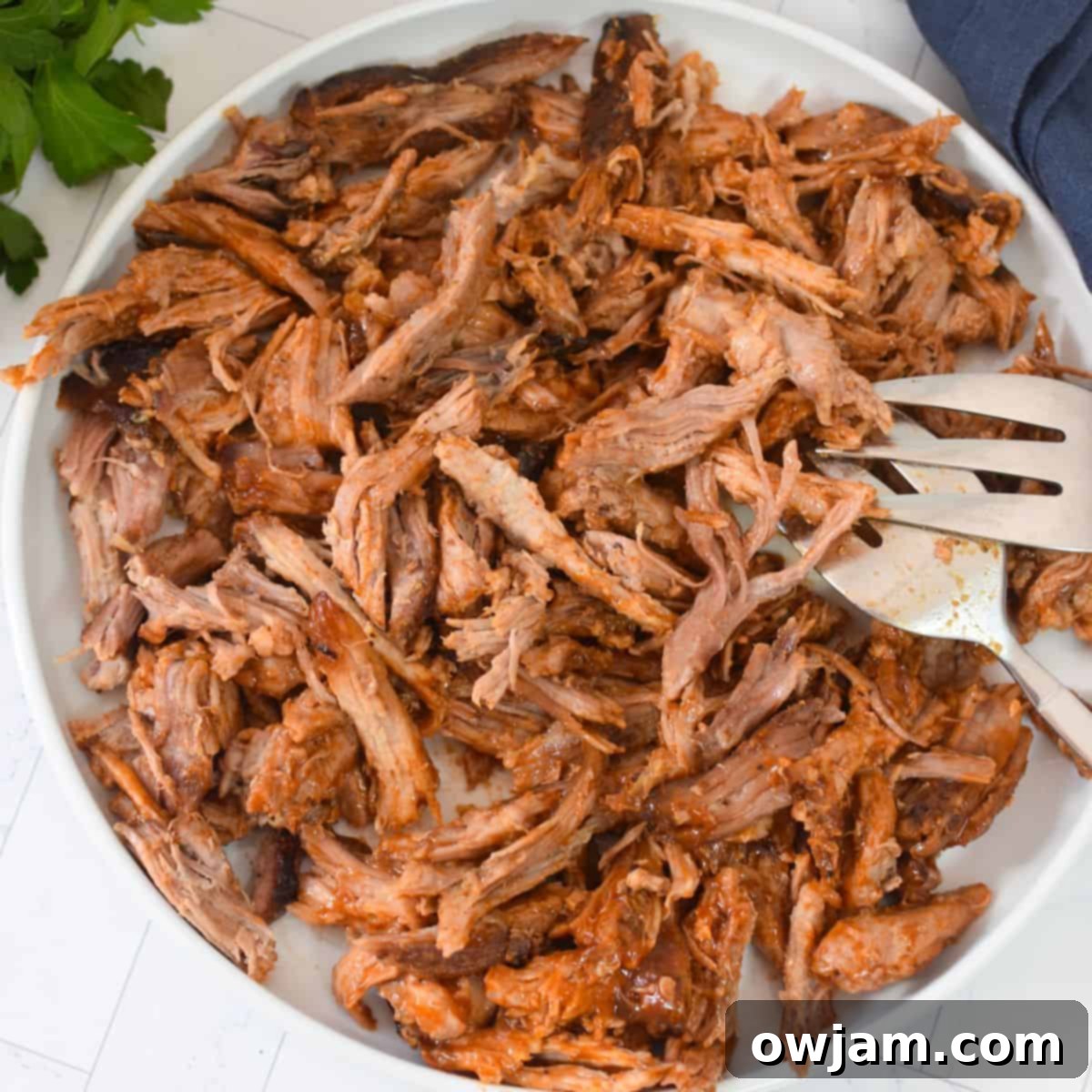The Ultimate Oven Roasted Boston Butt Recipe: Perfectly Tender Pulled Pork
Imagine the comforting aroma of slow-roasted pork filling every corner of your home. This **oven-roasted Boston butt recipe** is designed to deliver incredibly tender, juicy pulled pork with minimal effort, making it perfect for busy weeknights or relaxed weekends. It’s truly one of our go-to methods for easy meal prep, whether you’re planning hearty sandwiches, flavorful rice bowls, or a generous family feast.
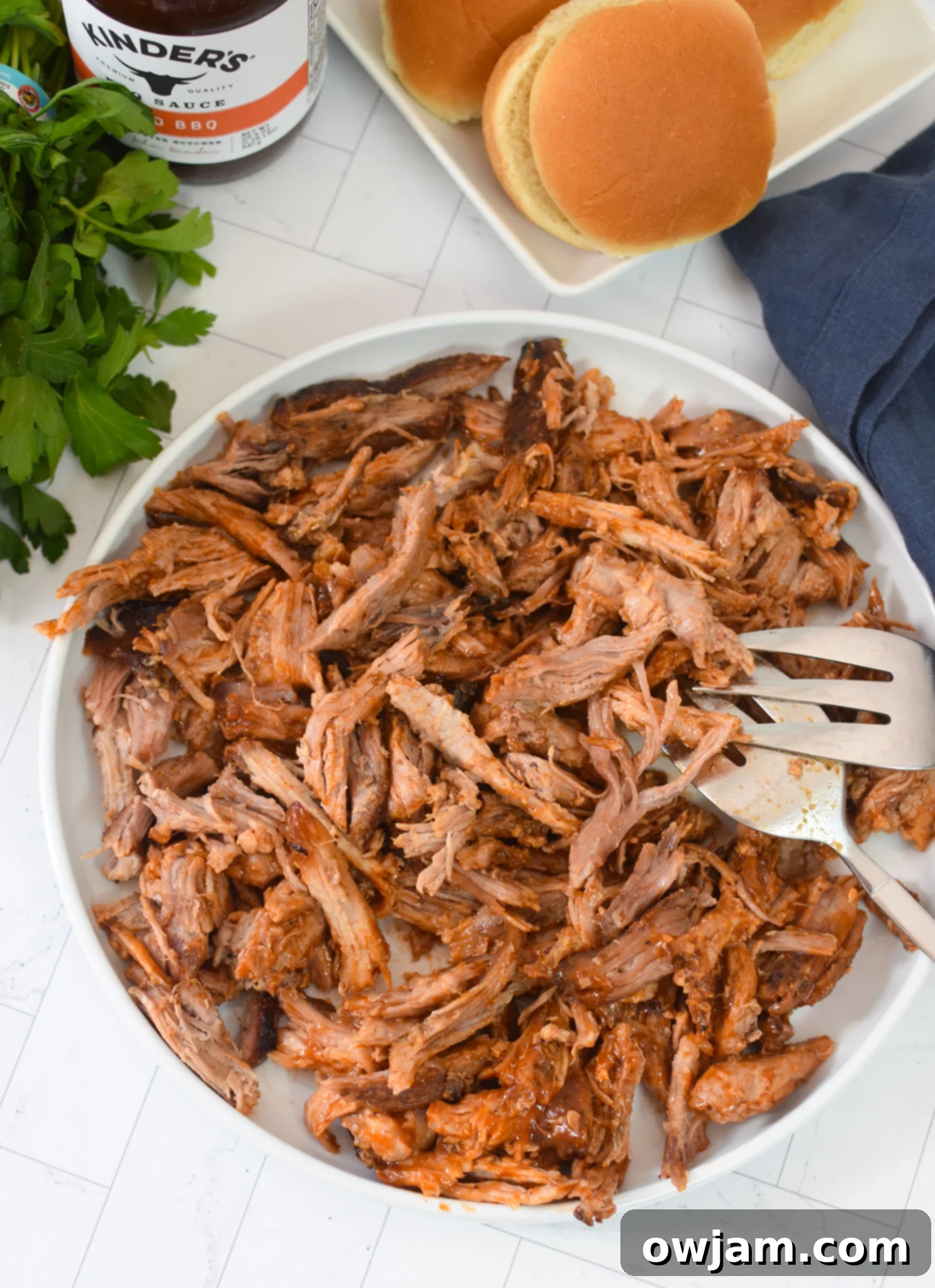
Why This Oven-Roasted Boston Butt Recipe Is a Game-Changer
Having experimented with countless pork recipes over the years, I can confidently say this Boston butt method stands out. The secret to its incredible success lies in a simple yet crucial technique: roasting it uncovered during the final hour. This allows the exterior to develop a beautiful, golden-brown crust while locking in moisture, resulting in pork that is unbelievably tender and bursting with flavor.
The **Boston butt**, also known as pork butt or pork shoulder, is an ideal cut for slow roasting. Its generous marbling and higher fat content render down beautifully during the long cooking process, ensuring the meat remains exceptionally juicy and flavorful. This natural richness is what gives pulled pork its signature succulent texture and deep, satisfying taste.
Beyond its deliciousness, this recipe is a dream for **meal prep**. With just three straightforward steps – **season, sear, and slow roast** – you’ll have a versatile batch of shredded pork ready to transform into a variety of meals throughout the week. Its ability to retain moisture and flavor makes it perfect for leftovers, and it’s always a crowd-pleaser for a hearty family dinner. It’s a truly fantastic slow-roasted pork recipe to have in your culinary repertoire!
If you’re a regular reader of A Cedar Spoon, you might recall some of my other popular pork dishes, like this comforting pork chili, the vibrant pineapple pork chops, or the incredibly convenient slow cooker pork shoulder roast. This Boston butt recipe perfectly complements that collection.
Essential Ingredients for Perfect Pulled Pork
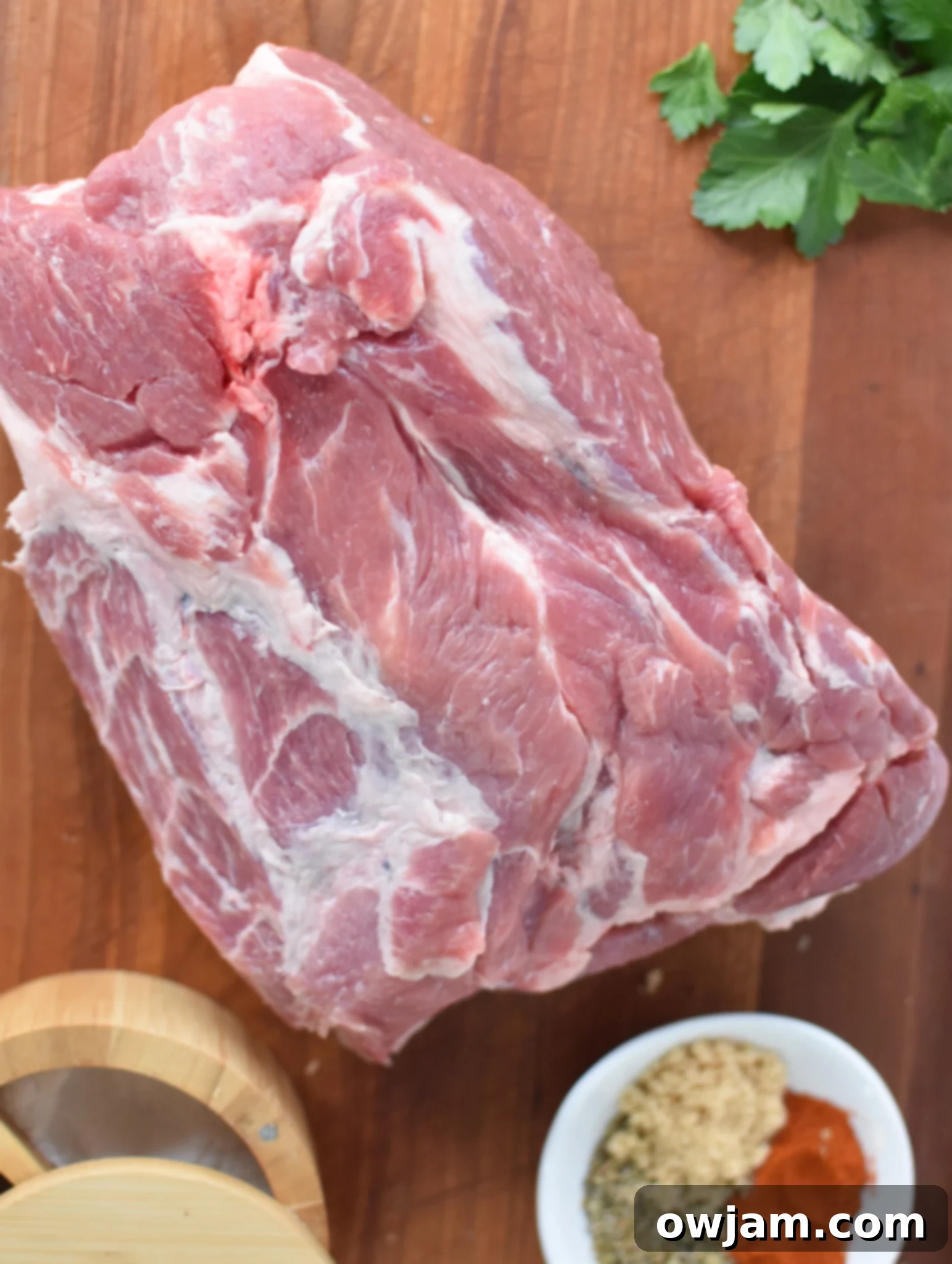
This recipe calls for a handful of simple ingredients, most of which you likely already have in your pantry. For precise measurements and detailed instructions, remember to consult the full recipe card below.
- Boston Butt (Pork Butt): This is the star of our pulled pork show. A heavily marbled cut from the upper shoulder, it boasts a rich fat content that melts into the meat during slow roasting, resulting in a fall-apart tender texture and deeply savory flavor. It’s the absolute best choice for a melt-in-your-mouth shredded pork experience.
- Salt and Black Pepper: These fundamental seasonings are crucial for building the flavor foundation. They not only enhance the natural taste of the pork but also help the spice rub adhere beautifully to the meat, ensuring every bite is perfectly seasoned.
- Garlic Powder and Paprika: Garlic powder introduces a mellow, aromatic warmth that is essential to any savory roast. Paprika adds a subtle sweetness, a mild peppery note, and contributes to the appetizing reddish-brown color of the pork’s crust, making it look as good as it tastes.
- Italian Seasoning: This versatile blend of dried herbs (typically including basil, oregano, rosemary, and thyme) infuses the pork with a balanced, earthy, and aromatic flavor profile. It wonderfully complements the richness of the pork without overpowering it.
- Brown Sugar: A touch of brown sugar in the rub provides a hint of sweetness that perfectly balances the savory spices. More importantly, it aids in creating that irresistible, slightly caramelized crust as the pork roasts, adding another layer of complex flavor.
- Barbecue Sauce and Buns (optional): While this pulled pork is delicious on its own, a good quality barbecue sauce is key for classic pulled pork sandwiches or sliders. It adds moisture, tang, and a smoky-sweet contrast that elevates the dish. Pair it with soft buns for the ultimate BBQ experience.
How to Cook Boston Butt in the Oven (Step-by-Step Guide)
Cooking a succulent pork Boston butt in your oven is easier than you think. The process involves seasoning, a quick sear, then a long, slow roast, initially covered, and finally uncovered, to achieve that perfect fall-apart tenderness and a delicious exterior.
Step 1: Prepare the Pork. Preheat your oven to 325°F (160°C). Carefully trim any large, excess fat caps from the surface of the pork butt. While marbling is good, thick fat layers on the exterior can prevent a good crust from forming. Pat the pork dry with paper towels to ensure the spice rub adheres well.
Step 2: Mix the Spice Rub. In a small bowl, combine the salt, black pepper, garlic powder, paprika, Italian seasoning, and brown sugar. Mix thoroughly until all the spices are evenly distributed. This blend will create a savory, slightly sweet, and aromatic crust on your pork.
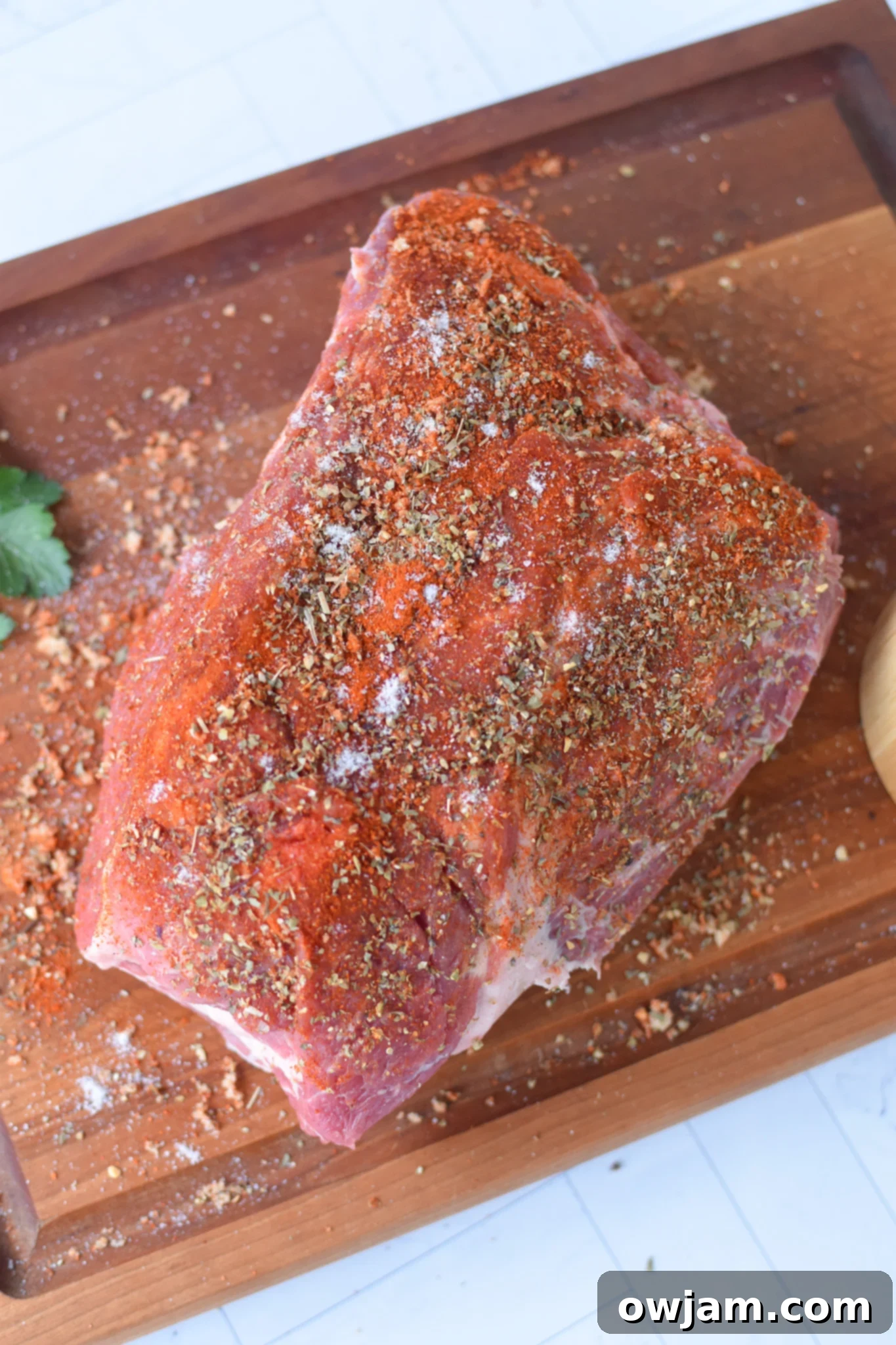
Step 3: Apply the Rub. Generously rub the spice mixture all over the pork butt, ensuring all sides are thoroughly coated. Don’t be shy – a good layer of rub is essential for maximum flavor. Press the rub firmly into the meat to help it stick. For even deeper flavor, you can do this step an hour or two in advance and let the pork sit at room temperature, or even overnight in the fridge.
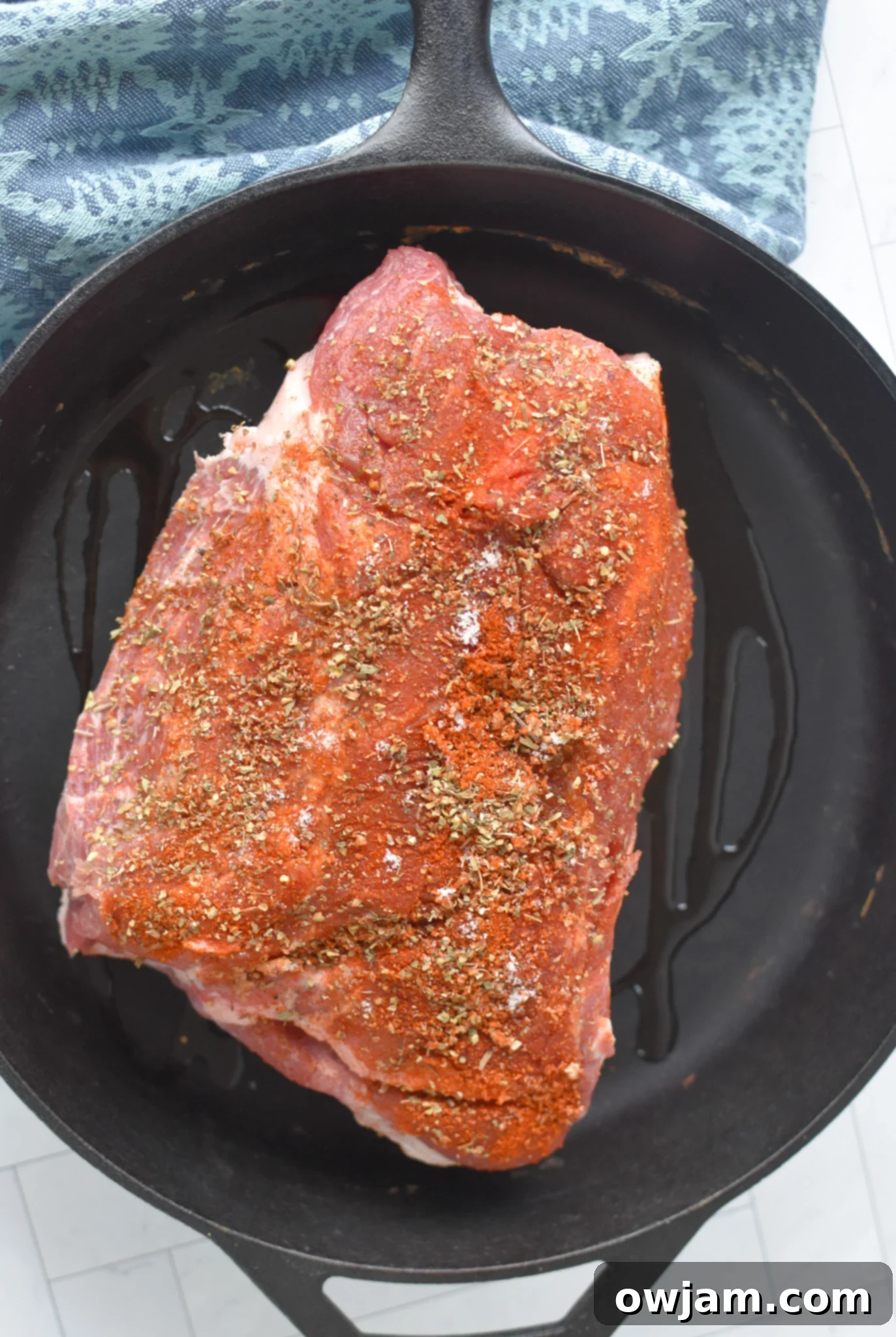
Step 4: Sear for Flavor. Heat a cast iron or other oven-safe skillet over medium-high heat. Once hot, sear the pork butt on both sides for approximately 2 minutes per side until a nice brown crust forms. Searing is essential as it locks in juices and creates a richer, more complex flavor through the Maillard reaction.
Step 5: Covered Roast. Tightly cover the skillet with heavy-duty aluminum foil. This traps moisture and creates a steamy environment, helping the pork become incredibly tender during the initial phase of cooking. Transfer the covered skillet to the preheated oven and roast for 3.5 hours.
Step 6: Uncovered Roast & Tenderness Check. After 3.5 hours, carefully remove the foil. Continue to roast for another hour, or until the pork reaches an internal temperature of at least 165°F (74°C) and is fork-tender, easily pulling apart. For classic pulled pork texture that practically melts in your mouth, aim for an internal temperature between 190–205°F (88-96°C). This extended cooking time at a higher temperature breaks down connective tissues even further, yielding exceptionally shreddable pork.
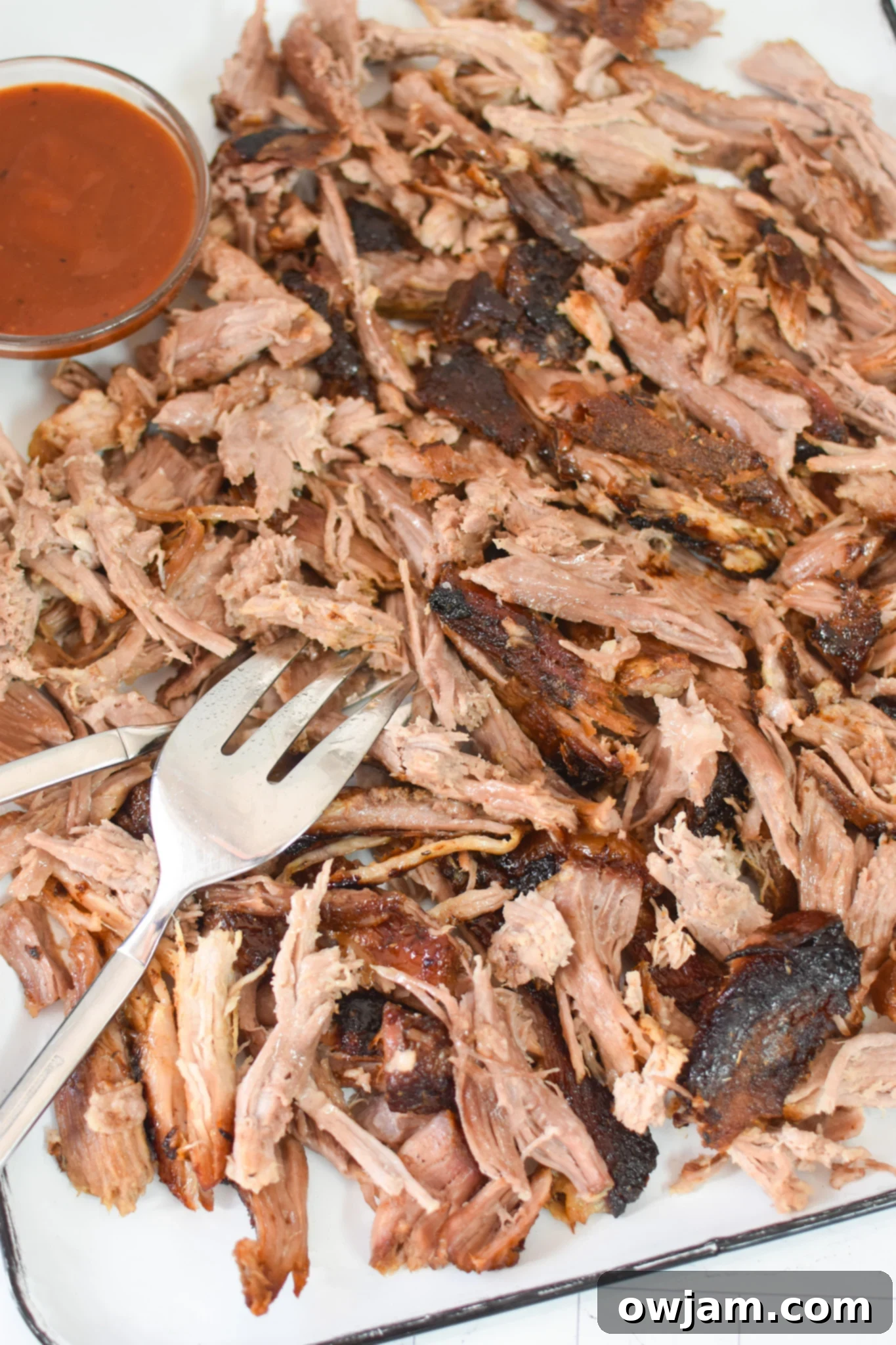
Step 7: Rest and Shred. Once cooked, remove the pork from the oven and let it rest for 10-15 minutes before shredding. This resting period allows the juices to redistribute throughout the meat, ensuring maximum succulence. Use two forks or meat claws to easily shred the pork. Serve it immediately with your favorite barbecue sauce on soft buns, over fluffy rice, or alongside classic side dishes like coleslaw or mac and cheese.
For more quick and delicious pork meals during the week, I also highly recommend making these baked pork chops in the oven, or for a tangy and sweet twist, try our BBQ baked pork chops version.
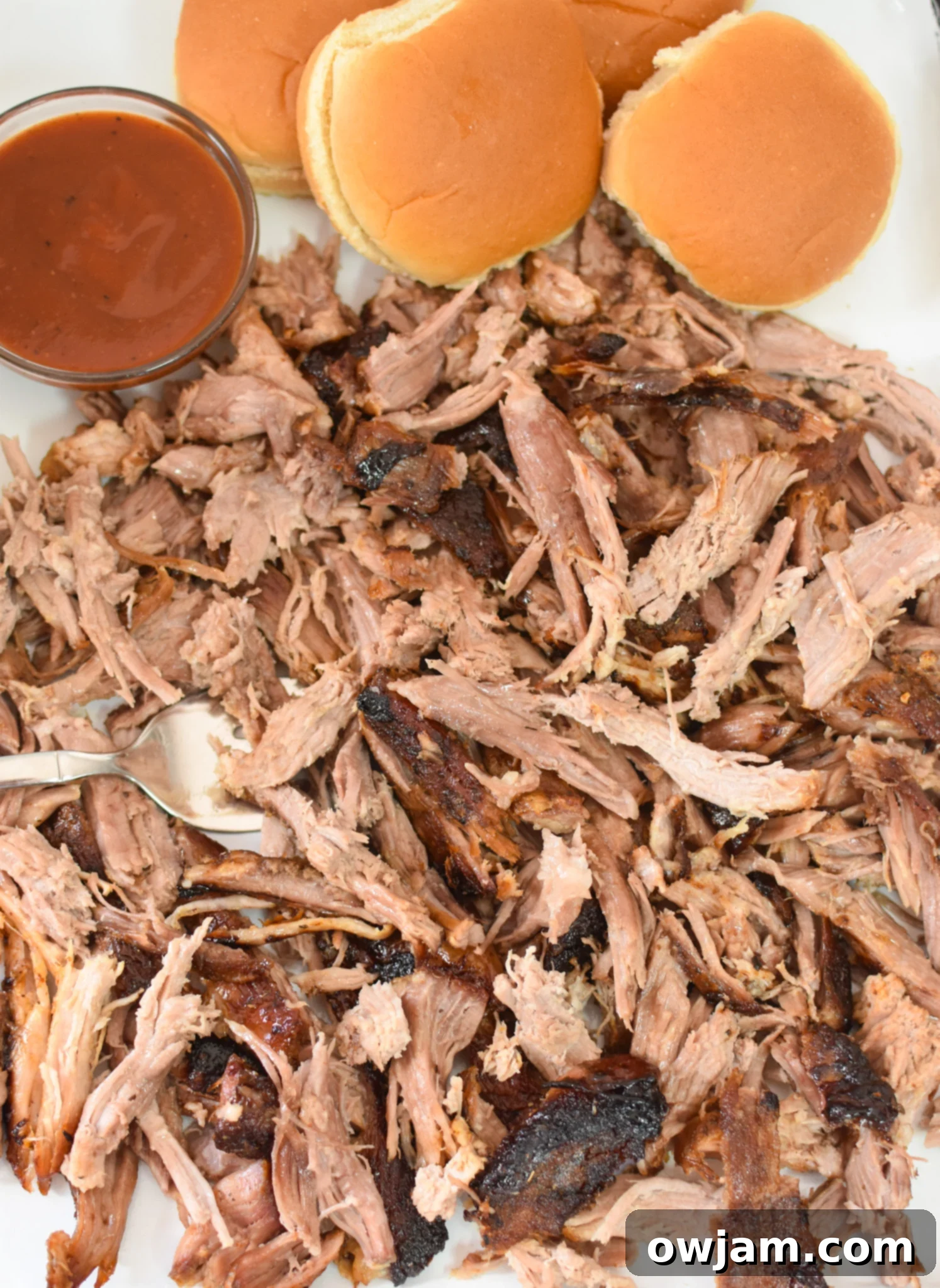
Pork Butt vs. Pork Shoulder: Understanding the Differences
While often used interchangeably, **pork butt** (also known as **Boston butt** or pork shoulder blade roast) and **pork shoulder** (sometimes called picnic shoulder) are distinct cuts from the same general area of the pig’s front leg. Knowing the difference can significantly impact your cooking results, especially when aiming for perfect pulled pork.
The **Boston butt** is cut from the upper part of the pig’s front shoulder, closer to the neck. It’s characterized by its rectangular shape and a significant amount of intramuscular fat, or marbling, along with some connective tissue. This rich marbling is what makes it exceptionally flavorful and keeps it incredibly moist during long, slow cooking methods. When slow-roasted, the fat renders and the connective tissues break down, resulting in that desirable fall-apart, shreddable texture. It’s truly the superior choice for any pulled pork recipe, pork carnitas, or even flavorful pork tacos.
In contrast, the **pork shoulder** (picnic shoulder) comes from further down the leg. It’s typically leaner than the Boston butt, often comes with the skin on, and may include a portion of the shank bone. While it can also be slow-cooked, its leaner nature means it benefits from moist-heat cooking methods and even longer cook times to achieve tenderness. It’s a great choice for braising, stews, or recipes where you want a slightly firmer texture, but for the ultimate juicy and succulent pulled pork, the Boston butt truly shines.
For this oven-roasted pulled pork recipe, the abundant marbling in the Boston butt is key to its success, ensuring a flavorful and fork-tender outcome every single time. Don’t be confused by the name “butt” – it refers to an old English word for a barrel or cask, where pork used to be stored, not the anatomical rear of the pig!
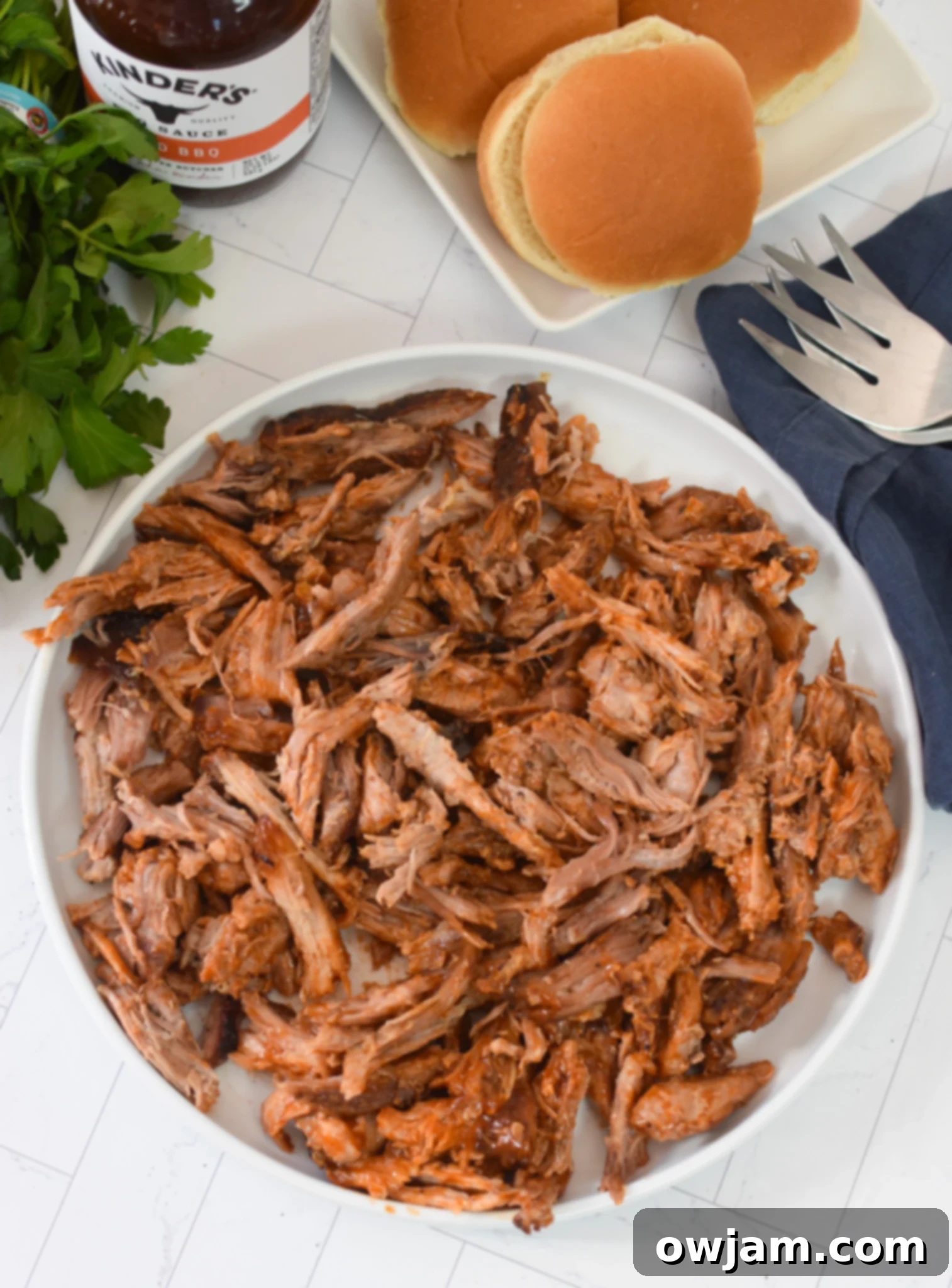
Storage & Freezing Tips for Leftover Pulled Pork
Proper storage is key to enjoying your delicious pulled pork for days to come. Store any leftover pork in a well-sealed, airtight container in the refrigerator for up to 4 days. When reheating, you can opt for the microwave for quick individual servings, or for larger quantities, reheat in a covered dish in the oven with a splash of broth or barbecue sauce to prevent it from drying out.
For longer storage, **pulled pork freezes exceptionally well**. Allow the pork to cool completely, then transfer it to freezer-safe bags or containers. If freezing in bags, press out as much air as possible to prevent freezer burn. You can freeze it in meal-sized portions for convenience. Properly frozen pulled pork will maintain its quality for up to 3 months. To thaw, simply transfer it to the refrigerator overnight, then reheat as desired.
Recipe FAQs: Your Questions Answered
While pork is safe to eat at 145°F (63°C), for incredibly tender, shreddable pulled pork, you’ll want to cook it until the internal temperature reaches between 190°F (88°C) and 205°F (96°C). This higher temperature allows the collagen and connective tissues to completely break down, resulting in that desirable fall-apart texture.
For a 5-pound Boston butt cooked at 325°F (160°C), you can expect a total cooking time of approximately 4.5 to 5 hours. This typically breaks down into 3.5 hours covered, followed by 1 to 1.5 hours uncovered, until it reaches the desired internal temperature and tenderness.
If there’s a significant fat cap remaining after trimming, it’s generally recommended to cook the Boston butt fat-side up. As the fat renders, it will baste the meat below, keeping it moist and adding flavor. However, if your roast is boneless and trimmed of most large fat layers, the orientation won’t make a huge difference.
Pork butt is very forgiving! If it’s not falling apart, it simply needs more time. Continue roasting, covered or uncovered, checking every 30-60 minutes, until it reaches the desired tenderness. Every oven and cut of meat can vary slightly, so always cook to temperature and texture, not just time.
While not strictly necessary for this recipe, adding about a cup of chicken broth, apple cider vinegar, or water to the bottom of the pan before covering can help keep the environment moist and add a little extra flavor to the pan drippings, which can be incorporated into the shredded pork later. This is particularly useful if you find your pork tends to dry out.
More Delicious Pork Recipes to Try
Pork
Air Fryer Boneless Pork Chops
Pork
Grilled Hawaiian Pork Chops
Pork
Slow Cooker Cuban Pork Rice Bowls
Pork
Easy Thai Pork Stir-Fry
Tried this recipe? Leave a star rating and comment below! Subscribe to my newsletter or follow me on
Facebook,
Instagram, or
Pinterest for the latest.
Juicy Oven Roasted Boston Butt for Pulled Pork
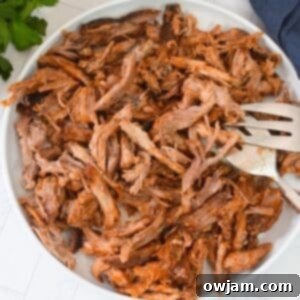
Pin
Ingredients
- 5 pound boneless pork butt, {Boston butt, a well-marbled cut ideal for shredding}
- 1 teaspoon salt
- 1/4 teaspoon black pepper
- 1 teaspoon garlic powder
- 1 teaspoon paprika
- 1 teaspoon Italian seasoning
- 2 teaspoons brown sugar
- Barbecue sauce, optional for serving, use your favorite!
- Buns, optional for serving, for pulled pork sandwiches
Instructions
-
Preheat the oven to 325 degrees F (160°C). Carefully trim any large, excess fat from the pork butt and pat dry.
-
In a small bowl, thoroughly combine the salt, pepper, garlic powder, paprika, Italian seasoning, and brown sugar. Generously rub this spice mixture all over the pork, coating all sides evenly.
-
Heat a heavy cast iron skillet or another large oven-safe skillet over medium-high heat. Sear both sides of the pork butt for about 2 minutes per side until a deep golden-brown crust forms. Once seared, cover the skillet tightly with aluminum foil.
-
Carefully transfer the covered cast iron skillet (or oven-safe skillet) to the preheated oven.
-
Roast the pork for 3 1/2 hours with the foil on. After this time, remove the foil and continue to roast for another hour, or until the pork is incredibly tender and easily falling apart when tested with a fork. The internal temperature should register between 190-205°F (88-96°C) for optimal shredding.
-
Remove the pork from the oven and let it rest for 10-15 minutes. Then, use two forks or meat claws to shred the pork directly in the pan, incorporating any accumulated juices. Serve hot with BBQ sauce on buns, over rice, or with your favorite side dishes.
-
Store any leftover shredded pork in an airtight container in the fridge for up to 4 days.
Notes
- Store leftover pulled pork in an airtight container in the fridge for up to 4 days. For reheating, use the microwave or a covered dish in the oven with a little broth to keep it moist.
- For longer storage, freeze the pork in sealed freezer bags or containers for up to 3 months. Thaw in the refrigerator before reheating.
- Don’t skip the searing step! It adds a crucial layer of flavor and helps develop a delicious crust.
- Adjust the spice rub to your preference. For a spicier kick, add a pinch of cayenne pepper.
Nutrition
Nutrition information is automatically calculated, so should only be used as an approximation.
